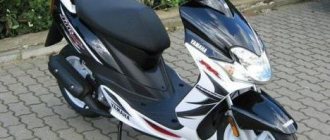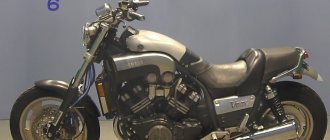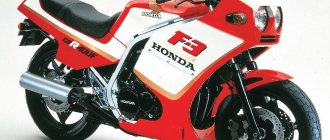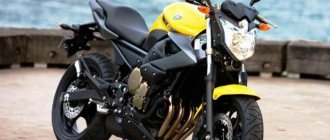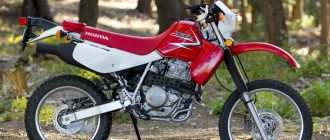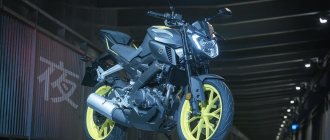Xin Kai Xin Kai 2012
- Hi all. I decided to make an addition about my first motorcycle. I remembered some nuances that were not mentioned in the review. There are positive moments, there are negative ones, and there are ambiguous ones. I probably won’t systematize it. I'll cram everything into one big list. So:
1. The light is bad. Near and far are practically no different, in the sense that both modes work frankly weakly. Can't see a damn thing. One could assume that the headlight was incorrectly adjusted, but this is unlikely, because all other pre-sale preparation was carried out by the masters of the Panauto-Yamaha salon very efficiently and conscientiously.
2. The footrests do not fold - this has both pros and cons. On the one hand, strong, tightly welded footpegs, in the event of a fall, protect the engine cover, brake levers and gearbox, as well as the pilot’s legs from damage (which is doubly nice). On the other hand, experienced bikers say that after a couple of serious falls, such footrests can bend and the ride becomes uncomfortable.
3. The maximum load on the trunk according to the instructions is only 3 kg. I bought a case, installed it on the trunk, opened it, and I saw a sticker inside: 3kg, 120km/h. An interesting coincidence. Both the trunk and the trunk are designed for the same load, and 120 km/h is exactly the maximum speed that I managed to squeeze out of this device on a long descent, while being in the aerodynamic bag of a large jeep. Whether to exceed the permissible load limit or not to exceed it is up to everyone to decide for themselves. If necessary, I repeatedly seriously overloaded the trunk, but at such moments I tried to drive more carefully than usual, slowly and smoothly overcoming bumps so that nothing would come off.
4. By the middle of the second season I noticed that I was constantly driving at full throttle. In fact, with increasing experience, the lack of power begins to be felt not only on the highway, but also in the city. The motorcycle begins to seem sluggish and unhurried. I can’t call this a disadvantage, because I believe that adequate requirements must be placed on any technology. It is foolish to expect the dynamics of a sportbike from a 125 cc motorcycle, but the fact remains: by the end of the second season, the owner of such a device will probably want to switch to something more powerful.
5. I would like to note the leisurely wear and tear of consumables on this motorcycle. After 17 thousand kilometers, the chain and sprockets are in good condition, and will probably last at least until 25 thousand. But the rear tire and rear brake pads already require replacement. The wear on the rear cylinder is critical, but for such a mileage this is the norm. But the pads, on the contrary, surprised me. I expected them to last longer, but I can't put off replacing them. When braking with the rear circuit, a strong grinding noise is heard, and there is practically no deceleration. Most likely, this is due to my driving style: rarely using the front brake only in critical situations, jerky movement with constant acceleration and braking between the rows and, as the great Freddie Spencer taught, using the rear brake in a turn to tuck the motorcycle into the desired trajectory.
6. The standard installed Chinese tubeless tires pleased me with their good puncture resistance. During the entire period of operation I encountered this problem only once. I noticed that the pressure in the rear wheel had dropped, found a self-tapping screw sticking out of the tire, screwed it in deeper and made it to the tire shop without any problems.
7. By the way, the tires are quite narrow: 80 mm in the front and 90 in the rear. For this reason, the motorcycle behaves extremely unstable on poor road surfaces, for example on sections of removed asphalt. It makes sense to replace the cylinders with wider ones after wear. It’s realistic to put 110mm back. Forward 90. A nice bonus - with thick wheels the motorcycle looks much more serious.
8. I was very pleased that in rainy weather the pilot does not get a waterfall of splashes from under his own wheels. Developed volumetric wings reliably cut off flows of water raised from deep puddles by the tire tread. A small portion of dirt only ends up on the toes of the shoes.
9. The maximum speed of a motorcycle depends greatly on the terrain, and even more strongly on the direction of the wind. A headwind and a steep climb can seriously slow down the bike, despite the throttle being fully open. A tailwind and a descent, on the contrary, give the motorcycle amazing lightness and suspiciously playful dynamics. But this is due to the fact that I am large, and my aerodynamic characteristics are lousy. A more compact pilot will most likely not feel such a strong influence of these factors on the behavior of the motorcycle.
10. A strong side wind introduces downright dangerous instability into the behavior of the motorcycle. You have to hold the steering wheel tightly so as not to accidentally end up in the next row after another rush. The same problems arise when passing oncoming traffic with large trucks and buses. This is due to the low weight of the motorcycle - only 126 kg.
11. The seat is large and flat - like a sofa. Riding together is unexpectedly comfortable. It’s not at all cramped and there’s room to fidget to stretch your butt on the go on a long journey. It’s even more convenient for one. However, due to the overly simple profile of the seat, on long-distance trips, approximately every 100 km of the road, an irresistible desire arises to stop and do 50 squats.
12. They say that even a liter changes its character when driving with the second number. I don’t know about the liter, but 125 cubes, after the passenger boards, changes like heaven and earth. Under double load, the motorcycle becomes completely sluggish and smooth. Acceleration dynamics deteriorate, maximum speed drops, and fuel consumption increases. When systematically driving together, the chain begins to stretch faster. But when you finally leave the passenger on the sidewalk, there is a feeling of frantic dynamics and unstoppable power, the motorcycle comes to life again!
13. An interesting thing in the design of the motorcycle is the fuel valve located under the gas tank, on the left. Its handle has three positions: “closed”, “tank” and “reserve”. In the closed position, fuel does not flow from the tank to the carburetor. In the “tank” position, the intake is carried out not from the very bottom of the gas tank, but from a certain level, below which approximately 2 liters still remain, just for the “reserve” position. Thus, if a motorcyclist forgets to refuel and the motorcycle stalls, having used up the main supply of fuel, it will be possible to switch the tap to the “reserve” position and get to the gas station without any problems. This solution will undoubtedly be useful for novice motorcyclists who do not have much experience in operating two-wheeled vehicles.
14. The fuel level gauge does not operate linearly. When filling a full tank, the needle rises above the extreme division, and for a long time does not want to fall from there. After about 100 kilometers, it suddenly begins to rapidly decline to the 1/3 mark, and then almost freezes again, going the rest of the way very slowly.
That's all I could remember about the operation of the YAMAHA YBR125 at the moment. There were more disadvantages than advantages, but they are not critical. Personally, I managed to quickly adapt to all the nuances of the motorcycle’s behavior. I believe that for such a price (82,000 rubles at the time of purchase in the summer of 2012), one cannot even dream of a better set of consumer properties. The most important advantages of this motorcycle - reliability and simplicity of design - are undeniable.
Thank you for your attention. Good luck and smooth roads!
Yamaha YZ125 2021
First and foremost, is the 2021 Yamaha YZ125 better?
No. The only difference between the 2021 version and 2021 is “high-quality new graphics” (that’s what manufacturers say and do when nothing else has changed in the model). Luckily, for once, the new graphics didn't increase the price, because usually the opposite is true. But there haven't been any major model updates since 2006, and used YZ125 two-strokes sell in large numbers and are easy to maintain, so the 2021 Yamaha YZ125's biggest competitor is not Husqvarna or KTM, but the older Yamaha YZ125s. Instead of going to a dealer, most people go to a classifieds site. And someday there will come a time when Yamaha will have to make a motorcycle from scratch, just to make it at least somewhat different from all those that are sold second-hand.
But is she good?
Yes, of course! Many people, including us, consider it the coolest fun bike on the market. The 125 two-stroke is so light that it can be controlled by thought.
What does it look like on the dyno?
Surprisingly, the Yamaha YZ125 outperforms its European rivals from idle to 8000. In a head-to-head comparison of the KTM and YZ, we found the YZ125 to have better throttle response and more noticeable low-to-mid rev pickup. The YZ125 is also less critical to rider errors; it is more convenient to regulate traction with the clutch when twisting. Unfortunately for Yamaha enthusiasts, after 7,000 rpm the balance of power tilts in the KTM's favor. At 7000 rpm, the YZ125 produces 16.3 hp, and the KTM only 15.37, but then the KTM’s power increases faster than its rival. In a nutshell, the difference between the two is that the YZ125 picks up speed quickly and settles into a smooth run right where the KTM starts to accelerate. The KTM reaches 29.45 horses at 9500 rpm, while the Yamaha YZ125 has 1.5 horses less at the same rpm. Yamaha reaches its maximum power at 11,600 rpm, and this is 35.36 horses, and KTM’s maximum at 11,300 is 38.23 horses. A difference of three horses is a lot for light octagons.
Is it good for young people?
Yes. Most AMA Pros put their kids on a YZ125 before they even let them dream of a 250 four-stroke. The Yamaha YZ125 is great for young riders transitioning from kids' 85s, as well as less experienced riders looking to improve. With a unique 125k power rating, they are a great learning desk for beginners. It's best to learn the importance of timely shifts, torque conservation, late braking and energy management on octobers. And the Yamaha YZ125 is better as a training bike than the KTM 125SX or Husqvarna TC125. How? A clearer response to the throttle and more powerful traction at the bottom. The Austrians require aggressive revving from low to mid to get to traction-effective revs, and for intermediates or pros this is fun, but risky for beginners.
Can the Yamaha YZ125 compete with the new KTM 125SX?
Yes, but not without investment. For full-fledged competition, the blue baby will benefit from the following gifts:
- Exhaust tract with muffler. About 2 horses plus.
- Reed valves. Boyesen Rad Valve or Moto Tassinari VForce4 will flatten the power curve.
- Tuning the cylinder and head. A competent tuner can increase airflow and reduce weight, squeezing out a couple more horses. True, you may need to switch to racing mixtures.
- Stars. Add one tooth back (from 48 to 49) and the ratios of all six gears become friendlier.
How does the Yamaha YZ125 compare to the KTM 125SX?
If you are a Yamaha YZ125 owner, don't even ride the KTM. Why? But because you will have to spend money on changing the bike after you feel the KTM’s top traction. You just won't want to go back to a Yamaha.
Yamaha YBR125 modifications
Yamaha YBR 125
Maximum speed, km/h—Acceleration time to 100 km/h, sec—EngineGasoline carburetorNumber of cylinders / arrangement1Number of bars4Working volume, cm 3124Power, hp / rpm 10/7800Torque, N m / rpm9.6/6000Fuel consumption, l per 100 km1.7Curb weight, kg125Gearbox typeMechanicalCooling systemAirShow all characteristicsWhat has changed in the Yamaha YZ125 since 2006?
The best thing Yamaha engineers have done to it over the years is install Kayaba SSS suspension in 2006, moving from 30 percent speed-dependent damping to 90 percent. As for the rear suspension, its monoshock was almost custom: 18mm rod (instead of 16mm), Kashima coating on the internal elements, 30% larger reservoir volume and a titanium spring. Unfortunately, since 2006 there have been no more important changes to the Yamaha YZ125.
Here's what's been done with it since then:
- 2007: The forks were made slightly tapered in the middle and a new damping valve was added. The steel components of the Kayaba shock absorber have been replaced with lighter aluminum ones. A large Protaper Contour steering wheel replaced the old steel steering wheel. In many components of the motorcycle, steel fasteners were replaced with aluminum. The perforated section of the muffler internals has been shortened by 75mm to improve throttle response without increasing exhaust volume.
- 2008: The YZ125 inherits the front brake, fork stays, fork bottom bracket and chain guard from the YZ250F. A new reed valve was added and the front brake master cylinder was reduced by 1.48 mm.
- 2009: Yamaha replaced the large steel brake hose holder with a lightweight aluminum one. The 2009 YZ125 also gets new seat trim and new Dunlop 742F front tires.
- 2010: New graphics
- 2011: Yamaha has stopped producing different versions of motorcycles for different markets. They switched to a single model with characteristics common to all markets. The main changes made to the global version were aimed at the ability to run on lower octane gasoline. For example, remember that in 2007 Yamaha shortened the muffler internals? So, in the 2011 version, they returned the length to where it was and increased the channel cross-section from 27 to 30 mm. In addition, the 410 main jet was replaced with a 430, and the 6BFY42-3 needle was replaced with a 6BFY43-3.
- 2012-2014. In addition to the entertainment of replacing the blue wing with a white one, and the white with a blue one, the versions of these three years differed only in new, extremely high-quality graphics.
- 2015: Unification of plastic design with four-stroke models, improved fork damping and a new air filter housing.
- 2016: gold chain, black rims and new, mind-blowing graphics.
- 2017: The front brake disc was increased from 250 to 270 mm, and the brake pad friction material was improved.
- 2018: The black rims were replaced with blue ones. Well, yes, graphics. New.
Reviews of the Yamaha YBR 125 motorcycle
- Yamaha FJR-1300 Reviews of the Yamaha FJR-1300 motorcycle
- Technical characteristics of Yamaha FJR-1300
- Additional materials Yamaha FJR-1300
- Reviews of the Yamaha FZ 400 motorcycle
- Reviews of the Yamaha FZ1 Fazer motorcycle
- Reviews of the Yamaha FZS 1000 Fazer motorcycle
- Reviews of the Yamaha Royal Star Venture motorcycle
- Reviews of the Yamaha SRX 400 - 600 motorcycle
- Reviews of the Yamaha TDM motorcycle
- Reviews of the Yamaha TT-R motorcycle
- Reviews of the Yamaha V-Max motorcycle
- Reviews of the Yamaha WR motorcycle
- Reviews of the Yamaha XJR 400 - 1200 motorcycle
- Reviews of the Yamaha XT 225 Serow motorcycle
- Reviews of the Yamaha XV1700 Road Star motorcycle
- Reviews of the Yamaha XVS1100 Drag Star motorcycle
- Reviews of the Yamaha YBR 125 motorcycle
- Reviews of the Yamaha YZ motorcycle
- Reviews of the Yamaha YZF R1 motorcycle
- Reviews of the Yamaha YZF R6 motorcycle
| RobbyMoto.Ru - short-throw throttle grips, clip-ons, footrests, traverses, tank caps, tackles, chain tensioners |
| Electronics for motorcycles - gear indicators, speedometer correctors, diagnostic and power enhancement units |
| Petal brake discs, brake pads, reinforced hoses for motorcycles and cars with quality assurance |
| City and racing zero resistance air filters for motorcycles |
| Starter lithium iron phosphate batteries for motorcycles |
| New generation silicone ester brake fluid |
Poll of the month View all polls
Handling Yamaha YZ125
How does the Yamaha YZ125 handle?
Surprisingly good for a bike that will soon be competing in vintage bike racing. In terms of handling, the YZ125 is still a modern model. We tested it on everything from asphalt to deep sand, and the handling in the sand especially surprised us. On dunes big enough to swallow the rider along with it, the YZ125 floats over obstacles with an ease that most 250s only dream of. Moreover, this lightweight device turned out to be so stable in the sand that it self-stabilized even after severe bumps.
Yamaha YZ125
There's an old saying among professional testers: "Slow bikes handle better." And this (unlike other tales of old men) is the pure truth: fast bikes constantly probe the rider, clog his hands and easily move from a smooth ride to “Oh yeah”. It’s easier to make a mistake on fast bikes, or, more accurately, it’s harder to make a mistake on slow bikes. Stable frame geometry and excellent low-end traction make the YZ125 a near-ideal model for those with the most basic skills.
Cons of Yamaha YZ125
Engine. The traction has to be adjusted with the clutch, because there is almost none at the top. If you overclock it a little, you won’t be able to accelerate, and this is the main drawback of the Yamaha YZ125.
Front tire. It’s not clear why we continue to put the front wheel on a Dunlop MX52 that’s not really good for anything. Simply replacing it with a Dunlop MX3S or MX33 can significantly improve the performance of the bike. Moreover, in the rear, these tires perform quite well, especially on hard terrain.
Technical characteristics of Yamaha Cygnus X 125
| Length - 1855 mm Height - 1110 mm Seat height - 775 mm Width - 685 mm Base - 1295 mm Clearance - 120 mm Fuel tank volume - 7.1 liters Gross weight - 112 kg Engine E343E, OHC Air cooling Cylinder-1 (52 mm, 4 valves per cylinder) Stroke 4 (piston stroke 57.9 mm) Carburetor | Engine capacity - 124.8 cc/cm Power 10.6 l/s at 8500 rpm Kick start + electric starter Speed max 100 km/h CVT drive (V-belt) Automatic clutch (centrifugal) Front telescopic suspension Rear pendulum suspension (shock absorbers) Front brake: disc Rear brake: drum Front wheel: 110-70-R12 Rear wheel: 120-70-R12 |
Yamaha Cygnus X 125 can be recommended as a corporate model. A driver in an office suit looks quite natural on this scooter. The scooter has sufficient ground clearance for traveling on country roads, so it can also be used as a country cruiser. For future buyers, we inform you: the average cost of a scooter produced in 2003-2008 is 105 thousand rubles. The Yamaha Cygnus XC125 is the perfect cruiser at a reasonable price.
Pros of Yamaha YZ125
Clutch. When you constantly keep it in the gray zone, you want to hope for its reliability. And it doesn't fail.
Suspension. Whether big or small, new or professional, Kayaba SSS suspension components perform exceptionally well. And they come stock across Yamaha's off-road lineup.
Service. Anyone who has handed over the keys at least once in their life is capable of rebuilding the YZ125 engine.
Armor-piercing. The reliability of the Yamaha YZ125 has become legendary - simply because the components, which have been tested for 13 years in not the most simple tasks, deserve to be called reliable.
Weight. A motorcycle weighing 90 kilograms (almost, see the technical specifications table below) is a very light and nimble motorcycle. On it you can overcome all those obstacles that friends on 250s will force.

